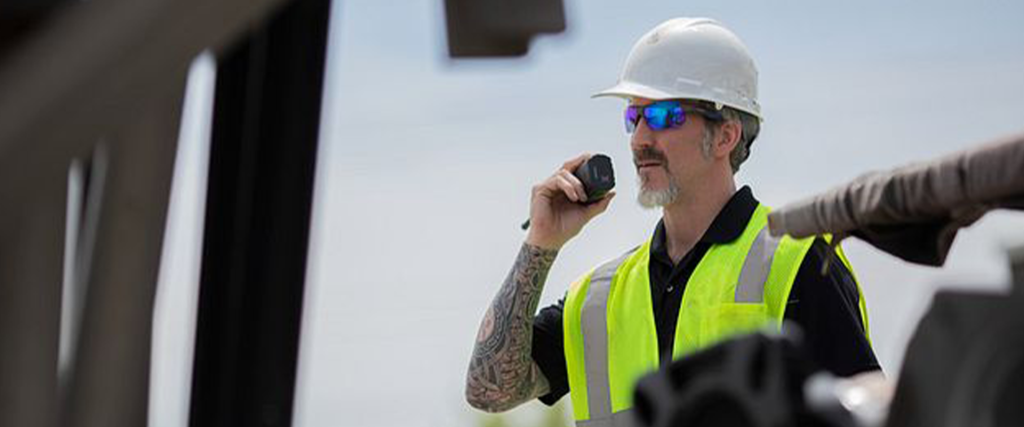Regarding your two-way radio system’s transmission range, what should you expect as a standard range of two-way radios? Are all two-way radio systems created equal? What are the differences between 2-way radios long-range (repeater systems) and standard-range 2-way radios?
These are very common questions regarding a two-way radio system’s transmission range. In this article, you will learn how 2-way radio systems work. You will also learn five(5) factors that play a part in the transmission range of your 2-way radio system.
1 . The Curvature of the Earth
Following is a somewhat simplified explanation of how the curvature of the Earth affects radio transmissions. Of course, other factors determine the exact transmission range of your radios. But because radio transmissions travel in a straight line, the curvature of the Earth affects the distance of your signal.
Your radio transmission will travel only to the distance of the horizon. At that point, it will keep going straight through the atmosphere and out into space!
Considering the nature of radio transmissions and what we know about the curvature of the Earth, we can estimate the distance of our radio’s range.
We simply take the distance above the surface of the Earth, in meters, of our antenna and find its square root. Then, we multiply that number by 3.569, which will give us our transmission range to the horizon.
Next, we do the same operation for the receiving antenna. Finally, we add the two together, and that’s our two-way radio system’s transmission range!
Here’s an example. Say you are 6 feet tall and you’re transmitting from a hand-held radio. Your transmitting antenna will be about six feet (1.83M) from the surface of the Earth.
The square root of that number is about 1.35. Next we multiply 1.35 by 3.569, and discover that our range to the horizon is about 4.82M or about 3 miles.
So, if the guy receiving the transmission is six feet tall and using a hand-held radio, the total transmission range will be about six miles!
2. Antenna Height
Antenna height can be a significant consideration when it comes to the range of your two-way radio system. However, as in the example above, it can be predicted relatively accurately. In fact, let’s take the same six-foot guy with his hand-held mobile.
Let’s have him transmit to a guy standing on a tower fifty (50) feet in the air this time! Again, the radio signal travels in a straight line to the horizon. And, again, the six-foot guy’s signal travels about 3 miles.
However, using the above calculation, the guy whose antenna is 50 feet above the Earth’s surface has increased HIS range to 8.65 miles. If we add 8.65 miles to the 6-foot guy’s 3 miles, we get a new radio system range of almost 12 miles (11.65 miles). So, antenna height is vital in determining your system’s transmission range!
3. Radio Frequency
The frequency of your two-way radio transmissions can also affect the range of your radio system. The two most widely used frequency bands in Land Mobile Radio today are still VHF (Very High Frequency) and UHF (Ultra-High Frequency). And while one is not superior to another, each can extend your radio transmission range in certain situations.
For instance, VHF has a longer wavelength. A VHF signal can better penetrate brick and mortar, wood, glass, and other solid objects (except steel) and travel farther outdoors in unobstructed environments. UHF, on the other hand, has a shorter wavelength. A UHF signal can get into tight places (between steel beams, re-bar, etc.) better than VHF. This ability to maneuver in close quarters gives UHF a better transmission range inside buildings or in downtown areas.
4. Power Output
Water loses pressure as it pushes through a pipe. Electricity loses power as it travels through a wire. Radio transmissions lose power as they travel through their environment.This is because energy suffers loss in power due to resistance on its way to fulfill its intended purpose!
Increasing power output at the source can help overcome this resistance and increase a system’s transmission range.
5. Repeater Systems
A Repeater System does exactly what its name indicates. A repeater receives a transmission from either a hand-held radio (1-5 Watts) or a mobile 2-way radio (25-50 Watts). The Repeater almost instantly re-transmits at very high power levels! It will usually do this from antennas high above the Earth’s surface.
A Repeater along with your hand-held or mobile two-way radios is an effective system. It provides a transmission range far greater than the two units can achieve without the Repeater.
Two-Way Radio System's Transmission Range
So, when someone asks, “What is this two-way radio system’s transmission range?” We respectfully reply, “That’s like asking how far a certain car will run?”
We will need to know more about your communications needs. We will need to understand how and where the radios will be used before answering the question with any accuracy.
By understanding how and where the radios will be operating, we can offer a reasonably accurate estimate of the transmission range of a 2-way radio system. However, there is only one way to be certain of a two-way radio system’s transmission range. And, that is to consult a certified Motorola two-way radio dealer like RCS Communications. Contact the experts at RCS Communications, and they will come to your location for a site walk and evaluate precisely what type of system will best suit your communications needs.

